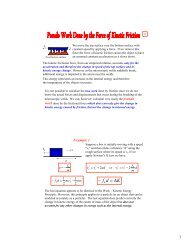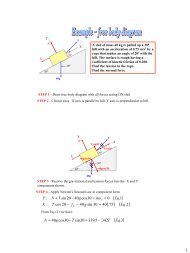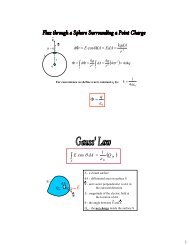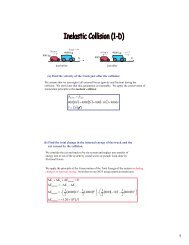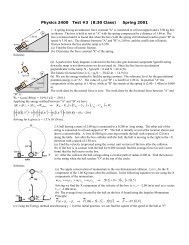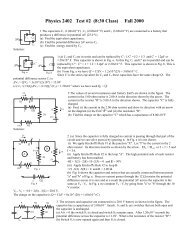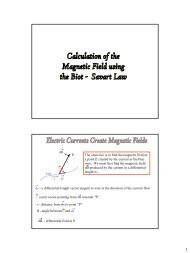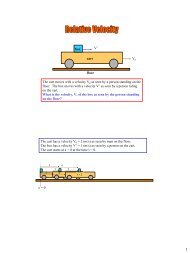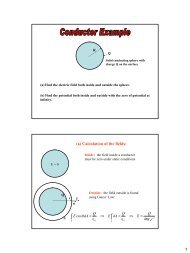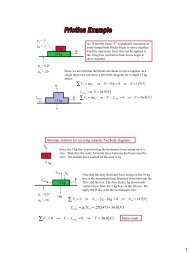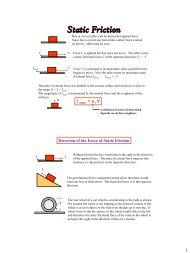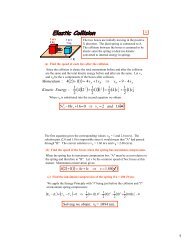Friction Laws and Work-Energy with Non Conservative Forces
Friction Laws and Work-Energy with Non Conservative Forces
Friction Laws and Work-Energy with Non Conservative Forces
Create successful ePaper yourself
Turn your PDF publications into a flip-book with our unique Google optimized e-Paper software.
the motion sensor release the block <strong>and</strong> move your h<strong>and</strong> out ofthe way as fast as possible. Be sure to catch the block before itcollides <strong>with</strong> the pulley. If the block seems to be moving tooslowly or too quickly you should change the hanging mass.•Examine the velocity versus time graph very carefully. Thevelocity should start at zero <strong>and</strong> then at some later time beginto increase in a uniform linear fashion (from zero) <strong>with</strong> time.However, it is possible that the velocity curve may suddenlyjump from zero to some other value before it increaseslinearly. This often happens when you do not move your h<strong>and</strong>rapidly away from the block after the Start button is clicked.Also the data should be as smooth as possible (which mightrequire changing the hanging mass, reducing the datacollection rate, improving the alignment of the motion sensoror changing the wide <strong>and</strong> narrow angle motion sensor modes.)Since you only need one data set to analyze for this part of theexperiment it is important to have the best possible data set.Check <strong>with</strong> your instructor if you are not sure your data issatisfactory.• You may find that the velocities measured just after theblock began to move are not very smooth. If this is the case,make a note of the time at which the data begins to increaseuniformly so that earlier data can be removed in Excel.• Construct a data table for the distance by dragging yourdistance data <strong>and</strong> dropping it on the table icon. In the sameway construct a second table for the velocity measurements.Go to your distance data table <strong>and</strong> highlight all of the time <strong>and</strong>distance values by moving the cursor to the top of the datatable where it should turn into a down arrow. Click <strong>and</strong> all ofyour distance <strong>and</strong> time data will be highlighted. Copy this datato the clipboard <strong>and</strong> transfer it to columns A <strong>and</strong> B of an Excelworksheet by pasting. Return to Data Studio <strong>and</strong> using thesame method copy <strong>and</strong> transfer the velocity <strong>and</strong> time data tothe same Excel worksheet in columns C <strong>and</strong> D.• Delete all of your data in columns A , B,C <strong>and</strong> D that wererecorded for times before the velocity data began to increaselinearly <strong>and</strong> smoothly. Similarly delete all data that occurredafter you stopped the block. You will notice that the times forthe distances <strong>and</strong> velocities are not the same since the velocityis computed from the distance measurements <strong>and</strong> therefore isobtained at a time halfway between two successive distancemeasurements. By cutting <strong>and</strong> pasting align the velocity <strong>and</strong>corresponding time columns as closely as possible <strong>with</strong> thedistance <strong>and</strong> its corresponding time columns.• Use columns E, F <strong>and</strong> G for the calculation of K, U <strong>and</strong> Erespectively. Compute the kinetic <strong>and</strong> potential energies usingequations 6 <strong>and</strong> 7. Examine the energies in your worksheetcarefully. The kinetic energy should increase <strong>with</strong> time, whilethe potential energy decreases. The total energy will decreasesince the kinetic friction force does significant work. If yourdata is inconsistent <strong>with</strong> these general observations you needto check your measurements or calculations.• The forces acting on the block <strong>and</strong> hanging mass areassumed to be constant. The work done by these forces isdetermined by the product of the force, the distance moved<strong>and</strong> the cosine of the angle between the force <strong>and</strong> thedisplacement. Therefore the work done depends linearly onthe distance. Since the work done determines the change inthe kinetic energy of the system, the kinetic energy mustdepend linearly on the distance. The potential energy of thehanging mass is “-mgd” <strong>and</strong> also depends linearly on thedistance. Since the kinetic <strong>and</strong> potential energies are expectedto be linear <strong>with</strong> distance, plot on a single graph the kinetic,potential <strong>and</strong> total energy as functions of the distance, not thetime. Be sure to use the scatter plot option not the line option.To place multiple plots on the same graph use the add optionbelow the series box. Check your X axis scale carefully.Your values should all be less than 1 meter. If your axishas values greater than one meter you have made an error.(Most likely you have used the line option rather than thescatter option.)• Examine the plots carefully. Do your measurements confirmin a qualitative fashion the <strong>Work</strong> – <strong>Energy</strong> Method when anon conservative force does work? Explain. Do a linear fit ofthe total energy versus distance plot. The slope should benegative indicating that the kinetic frictional force has causeda decrease in the total mechanical energy “E”. If the force ofkinetic friction f k acts on the block over a distance “ds”, thenthe work done by this force is:dW = f cosθds= − fkdsThe work done by this force causes a change in the totalenergy of the block:dW = dECombining these equations we obtain:f ds = −dEkPrint only your Excel Plots, NOT your data tables.⇒fkk= −dEdsAccording to this result, the negative slope of the total energyversus distance curve at any position must be the force ofkinetic friction. If the plot of total energy versus the distanceis linear then the slope of the tangent at any location isconstant <strong>and</strong> is the same as the slope of a linear fit which is theconstant kinetic friction force. From the slope of your linearfit, find the kinetic friction force acting on the block.• Using this frictional force <strong>and</strong> the known normal force onthe block, calculate the coefficient of kinetic friction betweenthe block <strong>and</strong> the plank. Find the percent difference betweenthis value <strong>and</strong> the mean value found in Part A.



